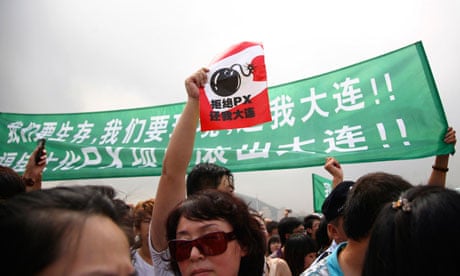If there were ever any doubts that there is one rule for the urban rich and another for the rural poor in China, they should have been removed this week by the vastly differing tales of two chemical plants.
The first is the Fujia factory in Dalian, a $1.5bn modern facility that produces paraxylene (PX), a mildly toxic chemical used in plastics. This facility was targeted at the weekend by tens of thousands of students, white-collar workers and other residents of the affluent coastal city. The demonstration was large, peaceful and apparently successful. It was organised by internet and mobile phone and widely covered by the domestic and foreign media. The city mayor spoke directly to the crowd and reiterated an earlier promise to relocate the factory. Police even gave directions to some of the protestors who were looking for the rally.
The second is the Luliang Chemical factory in rural Yunnan, one of China's poorest provinces. The plant was found this week to have dumped more than 5,000 tonnes of waste chromium - a known carcinogen - in the nearby hills and the Nanpan river. Local farmers and doctors have been complaining for many years about the discharges from this and other factories in the Luliang Industrial Park, but the local environment department appears powerless. When I visited the nearby Xinglong village for a video report last year, the water was red and yellow water, the smell was so bad I choked, and villagers told me cattle were being poisoned and cancer cases were on the rise. When they protested, they were at first ignored or arrested, then given paltry compensation.
So what explains the very different responses of the authorities and the media to the NIMBY (Not in my backyard) protests in Dalian city and Xinglong village? The size of the protests may be relevent; the number of demonstrators in Dalian was several times bigger than the entire population of Xinglong. Geography also offers a partial explanation; it is easier for the authorities to hide scandals deep in the Yunnan countryside than in an international coastal city.
But most significant is surely the composition of the protesters, the chemicals they oppose and the stage of development of their local economies.
The middle class protest against PX in Dalian this week was, in many ways, a re-run of a similarly successful demonstration against the same compound in Xiamen four years ago. In both cities, average annual incomes are now well above the $6,000 level at which citizens in developed countries started demanding more political rights and cleaner environments. PX may not be a deadly poison, but it is now a proven irritant for these influential white collar workers. With this in mind, the governors of Tianjin, Qingdao, Ningbo, Nanjing, Liaoyang, Quanzhou, Zhangzhou, Huizhou, Luoyang and Urumqi may well have to reconsider their PX projects or face copycat demonstrations.
Meanwhile in the countryside, chemical plants dealing with far deadlier toxins - such as cyanide, mercury, cadmium, sodium dichromate and yellow phosporus - will continue to stir up local unease, spark violence and generate the occasional headline, but their cases are unlikely to gain anything like the same political traction.
Far from its roots, the Chinese Communist party is now clearly more concerned about creating a clean urban environment for the middle class than it is about protecting the old rural environment for the farming masses. No surprise there. It is exactly what rich countries have done to the developing world for the past century.

Comments (…)
Sign in or create your Guardian account to join the discussion